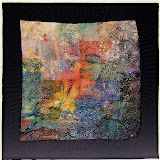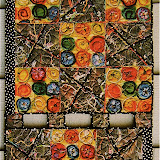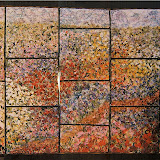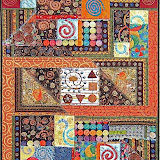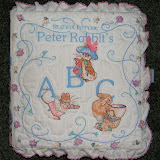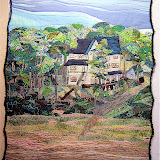I thought you may like to see the stages to complete this "ortwork" collage piece that features the Smoky Mountains. The background pieces from my scrap bag were laid out to establish the basic placement of the mountains, groves of trees, and sky during the Friday afternoon demonstration at the gallery in Gatlinburg. I had in mind to portray the new growth that I had observed on the drive to the mountains. This step is akin to doing an "under painting".
 Friday evening at home I added details with more bits of fabric scraps. There was a lot of cutting with scissors and the rotary blade. Angora yarn and wool roving was used to soften and blend areas.
Friday evening at home I added details with more bits of fabric scraps. There was a lot of cutting with scissors and the rotary blade. Angora yarn and wool roving was used to soften and blend areas.
 A pale, muted red-violet tulle was laid over the surface to trap all those bits and pieces in place. Lots of pins held this sandwich of backing, batting, scraps, wool, and tulle together. I used a variety of threads, many of them variegated, to quilt patterns that suited each area of the scene. I like to use the zig-zag stitch setting for free-motion quilting of the trees.
A pale, muted red-violet tulle was laid over the surface to trap all those bits and pieces in place. Lots of pins held this sandwich of backing, batting, scraps, wool, and tulle together. I used a variety of threads, many of them variegated, to quilt patterns that suited each area of the scene. I like to use the zig-zag stitch setting for free-motion quilting of the trees.
 It was then pinned to the design wall. Oil stick pastels were used to highlight and define shapes and edges. This is a slow process. After adding a touch of color or shading I need to leave the room or do something else before I can assess it with a "fresh eye" to see if the addition is convincing. A black permanent ink brush tipped marker was used to add more tree trunks and branches to the grove of trees in the foreground. To set the pastels the piece was sprayed with Krylon's clear acrylic. I use the one that has a UV ray protection to help guard against fading over time.
It was then pinned to the design wall. Oil stick pastels were used to highlight and define shapes and edges. This is a slow process. After adding a touch of color or shading I need to leave the room or do something else before I can assess it with a "fresh eye" to see if the addition is convincing. A black permanent ink brush tipped marker was used to add more tree trunks and branches to the grove of trees in the foreground. To set the pastels the piece was sprayed with Krylon's clear acrylic. I use the one that has a UV ray protection to help guard against fading over time.
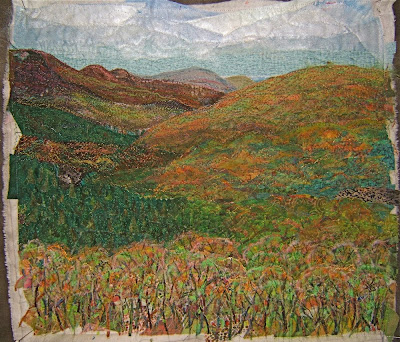 I squared it up trimming away the unfinished edges. You may recognize the fabric frame from the large mountain piece recently completed. I had intentionally made more than was needed for that piece, just in case I goofed cutting a mitered corner. Sure enough, I did ... and still had enough leftover to frame this one.
I squared it up trimming away the unfinished edges. You may recognize the fabric frame from the large mountain piece recently completed. I had intentionally made more than was needed for that piece, just in case I goofed cutting a mitered corner. Sure enough, I did ... and still had enough leftover to frame this one.
 "Spring from Morton's Overlook"
"Spring from Morton's Overlook" (2009)
20"x 18"
To see the other four "ortwork" collage pieces featuring this same view click on the
Smoky Mountain Quilts lable.


























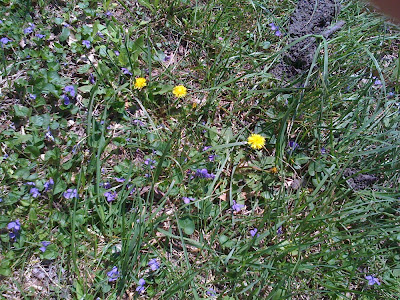




















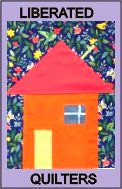 Fabric Bird Sculpture Pattern
Fabric Bird Sculpture Pattern




